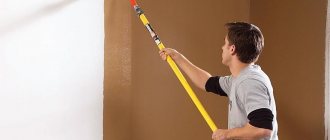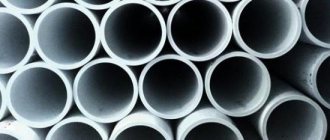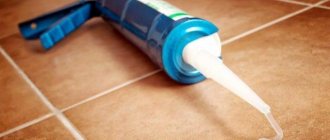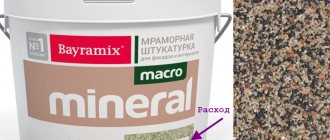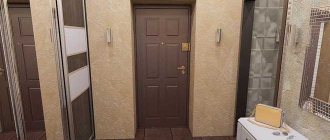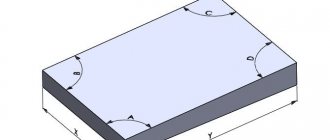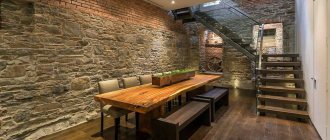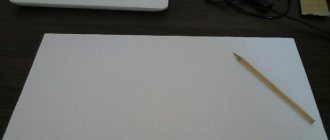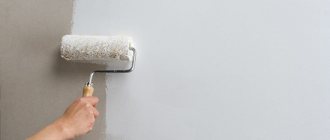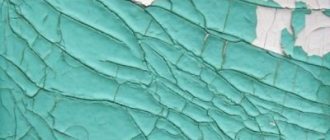Consumption rate of façade paint per 1m2
The starting point for determining purchase sizes is the material consumption per square meter of area. There is no single calculation formula, since the volume of solution required for uniform coverage depends on several factors:
- Number of layers;
- Structures of the painted surface;
- Difficulty of work;
- Tool used;
- Type and color of tinting composition;
- Preliminary surface preparation.
With the number of layers, everything is relatively clear - the higher the number required for a dense, uniform coating, the larger volume of mixture will be required. It should be taken into account that with each subsequent application the consumption will decrease, and if for the first application the consumption of façade paint per 1 m2 will be 300 g, then in the second the same amount will be enough for an area 2-2.5 times larger.
The structure of the building material on which the solution is to be applied also matters. Textured, relief coatings have a larger surface per unit area and require an increase in calculated figures. Therefore, the consumption of facade paint per 1 m2 on plaster with a relief surface exceeds the same figure for smooth coatings. In particular, the consumption of facade paint for bark beetles will be 15-20% higher. If porous bases are subject to finishing, then part of the composition will penetrate into their structure, increasing costs by 8-10%.
Photo from the site prof-fasad.od.ua
The complexity of the work means a large number of protruding elements, joints and corners, as well as a combination of different colors and shades. Coating that requires clear lines or in hard-to-reach places is usually done with a brush and requires the use of an additional amount of coloring solution.
The tool used by the painter determines not only the convenience and speed of manipulation, but also the cost-effectiveness of using building materials:
- From a cost point of view, the optimal method of application is a spray gun (painting gun), which allows the composition to be applied in the thinnest possible layer.
- Average consumption can be achieved by using paint rollers. A convenient option for the facade would be a roller with a telescopic handle, which allows you to paint at a considerable distance from the painter.
- Brush coating is the most labor-intensive and time-consuming process and uses the most material. But you still won’t be able to avoid using brushes in corners and joints.
Measurements of the room and calculation of the area of the surface to be painted
In order to determine the required amount of dye, it is necessary to measure the area to be treated. To do this, you need to know the dimensions of the wall (length, height) and window and door openings, i.e. those areas that do not require painting.
By determining the total surface area and subtracting the area of windows and doors from it, you can obtain the value of the processed surface. Based on the calculation of the material required to consume water-based paint per 1 m2 of wall in 2 times, you can obtain the total amount of material required for painting.
Please note: High-quality painting of heating radiators with powder paint with hot polymerization
Technical characteristics of primer-enamel for rust 3 in 1
Any owner sooner or later faces wear and corrosion of his favorite external or internal items. And I really want to give things a second life! What materials can help with this?
Purpose
Primer-enamel 3 in 1 is a universal composition for restoring the appearance of metal structures. This is a metal paint that does not require prior priming and performs the following functions:
- eliminating pockets of rust on the metal surface and preventing its further spread,
- coating the product with a primer that promotes better adhesion to paint,
- painting the surface of the structure with decorative enamel.
Thanks to the combination of functions in primer-enamel, there is no need to apply several layers of different materials to the product and wait for them to dry completely before applying each subsequent one. This significantly saves time and money, and also allows you to reduce the number of working tools.
Most often, primer-enamel is used to cover outdoor structures: gratings, fences, gates, garages, doors and street furniture. This is explained by the fact that primer-enamels are atmospherically resistant to humidity, cold and sun. But it is also possible to use the composition for decorative purposes - for coating various interior items.
It should be noted that primer-enamel is widely used in car repairs, especially its internal parts. Hard-to-reach places where there is constant contact with oil, steam or high temperature can be easily covered with one or several layers of primer-enamel. After this, the car components become resistant to aggressive influences.
In industry, these compounds have also found their place due to their chemical resistance to oils, aggressive environments, water and steam. They are used to cover elements of industrial and building structures, hangars and warehouses.
Primer enamel can be used not only for cast iron, steel and aluminum products. It is often used to coat wooden, concrete, mineral and brick surfaces both indoors and outdoors.
Ease of use, good appearance of the products and availability in stores make this coating an indispensable assistant in the household.
The versatility of primer-enamel is ensured by the presence of several components in its base.
- Alkyd-urethane varnish. This is a quick-drying composition of alkyd resins combined with urethane components. It is a connecting component.
- Anti-corrosion materials. Two components should be distinguished here: anti-corrosion pigments, which prevent the formation of new foci of rust, and rust modifiers (or converters), which neutralize existing corrosion. Such additives form a phosphate film on corroding areas.
Technical characteristics of primer-enamel for rust 3 in 1
Main purpose and scope of application of primer-enamel. What are its technical characteristics and consumption per m2? What are the main advantages of primer enamel? What features need to be considered before using the material? What is good about enamel primer for rust 3 in 1? What feedback do customers leave about the use of this composition?
Factors affecting paint consumption
To determine the required amount of water-emulsin solution, it is necessary to take into account the type of emulsion chosen - it can be made based on silicone, acrylic resin, silicates, and minerals. But when making calculations, you need to take into account the potential influence of other factors:
Table for calculating water-based paint.
- dyeing method;
- humidity and ambient temperature;
- preparing surfaces for painting;
- the planned number of layers of emulsion application.
The most advantageous method of painting is spraying paint with a spray bottle. When using it, it will be possible to reduce the consumption of color emulsion and increase the speed of work. But it is better to entrust painting walls with a spray gun to professionals.
The volume used will be slightly higher if you paint the floors with a roller. When using it, the composition is evenly distributed over the surface to be painted. You just need to choose the right type of roller.
If you take a tool with long pile, then the required amount of water-based solution for the same area of walls and ceiling will increase by 1.5 times.
The maximum consumption of paint emulsion will be if you use paint brushes for painting. When using them, lint marks and streaks may remain on the walls.
Varieties
The modern paint market is represented by a huge assortment; there is also a place for facade paints. The most common coloring mixtures are acrylic, silicate, silicone, latex and textured.
Acrylic mixture is the most popular and inexpensive option for painting exterior walls. Interacts with almost all materials from which a building can be constructed. After drying, it creates a durable protective film that serves as protection from environmental influences. Does not fade, is resistant to abrasion and does not form cracks. Such paints are not suitable for covering walls made of lime plaster and sandstone.
For such surfaces, silicate paint is more suitable. It is produced on the basis of silicate glue, to which mineral pigments and fillers are added. The service life of this type of glue is 25 years. It is waterproof and provides reliable adhesion to the material it is applied to. Resistant to any weather conditions. This mixture is suitable for use on concrete and brick. Its weak side is that it is subject to mechanical stress and is not elastic enough, so it can crack after drying.
Silicone paints are considered one of the best for painting plastered facades. In terms of their characteristics in terms of elasticity, resistance to mechanical damage and price, they lag behind acrylic compositions, and that is why they are not so widely used. After applying this type of paint, the plastered surface does not absorb moisture, but has a high level of vapor permeability and is resistant to temperature changes. After drying, the coating is able to repel dust and is not exposed to sunlight.
Latex or water-dispersion mixtures are made on the basis of polymer components. The combination of latex and acrylic made it possible to increase the operational capabilities of the compositions and increase the scope of their application. They can be used for exterior and interior decoration, but before application the surface should be thoroughly primed to avoid further appearance of fungi and mold. This composition can be used to paint any type of surface. It has no pungent odor, is environmentally friendly, is breathable and fireproof. Water-based paints can be diluted with water. They dry quickly and are resistant to moisture. The only drawback is that it is not possible to tint them in bright and rich colors.
Textured or structural painting compositions are suitable for creating decorative coatings not only on facades, but also on other elements of buildings. They do not require careful surface preparation and can be applied to cracks and chips at corners. The paints contain special plasticizers that help create a unique protruding pattern. The composition has high frost resistance, is resistant to ultraviolet rays, is insensitive to dampness, and has dust- and dirt-repellent properties. Does not crack due to high ductility. It can be applied to any surface - both brick and wood.
Types of emulsion paints
Emulsion dyes vary in their composition and can be:
- acrylic;
- silicone and silicate;
- based on latex and polyvinyl acetate.
Each type has its own properties and scope of application.
Acrylic paint
Acrylic emulsion
Acrylic emulsion is the most popular due to its advantages: moisture resistance, resistance to mechanical stress, durability and good performance characteristics. Paints based on acrylic resins can be used for exterior work, for example, when finishing the facade of a house.
Coating for the first time requires more consumption due to the fact that the dye is partially absorbed into the surface being treated.
Silicone emulsion
The dye is based on silicone, which is mixed with other components and creates a vapor-permeable coating.
The scope of application of silicone-based emulsion is the treatment of floor coverings. Advantages include moisture resistance and the ability to fill cracks and crevices no larger than 2 mm when applied. This coloring material is in demand when finishing interior spaces in two layers.
Pay attention to: How to paint the ceiling in the bathroom?
The difference in the amount of paint for layers 1 and 2 is due to the fact that the initial coating is a base coat and penetrates the porous surface, creating a uniform, smooth structure, as a result of which part of the dye “goes” into the wall.
Silicate emulsion
The dye is based on liquid glass, so the surface treated with this material is impact-resistant and resistant to mechanical stress.
The disadvantage of silicate emulsion is its poor resistance to moisture, so this dye is not suitable for walls in rooms with high humidity, such as bathrooms and kitchens.
Although the basecoat forms a strong film, the material has a high drying rate, and reapplying a recoat requires almost the same consumption.
Latex emulsion
The dye contains polymer substances, thanks to which the latex emulsion does not require special preparation of the base surface. The features of this material include the ability to perform a priming function: before applying the main coating, the latex emulsion can be diluted with water in a ratio of 1:5.
Latex paints dry faster, can have a matte or glossy appearance, and are used for both exterior and interior applications.
Polyvinyl acetate emulsion
Polyvinyl acetate emulsion
It contains PVA glue, which is characterized by reduced moisture resistance. Therefore, a dye based on polyvinyl acetate can be used, for example, when treating ceilings of dry non-residential premises.
In addition to PVA glue, the material may contain cement or slaked lime. It is recommended to apply it to brick or concrete surfaces.
Rules for calculating the amount of paint
The first step is to calculate the perimeter of the room; to do this, multiply it by the height of the ceilings. Next, subtract the area of windows, doors, etc. This gives you the number of square meters that need to be painted.
To find out how many liters are needed, you need to multiply the volume of the composition used (the number indicated on the back of the jar instructions) by the area of the walls. Do not forget that this amount is under ideal (or close to ideal) conditions.
Surfaces
When painting the walls in an apartment, this issue may not be so relevant, however, in apartments there are decorative elements made of various materials. In addition, this example shows how much the consumption depends on the roughness of the walls.
Paint consumption per 1 sq.m. surfaces:
- 70-150g wood;
- 100-150g metal;
- 150-250g concrete, plaster.
These data are provided for comparison of materials. Since it all depends on the depth of the unevenness, the base for painting, and the type of paint.
An extra layer of acrylic primer can increase the adhesion of the wall and even out minor defects and irregularities. The consumption of the coloring composition in this case is reduced by 13-18%.
When to paint multiple layers
Painting in two or more layers will be required in the following cases:
- when working on a wooden surface being processed for the first time;
- if you want to achieve a deep saturation of a matte shade;
- with a liquid consistency of the composition;
- when using bright colors;
- when applying one layer vertically, the other horizontally.
Method of application and consumption
A spray gun is considered an economical method, but when using it with a spray range, it is worth calculating the distance from windows and surfaces that should not be painted.
The best option is a roller, it is easy to use, and the paint consumption is lower than when using a brush.
The brush allows you to embody design delights, but has long become an outdated method.
The consumption of the composition largely depends on its texture; it is logical that a thick one will take more.
What determines the amount of coloring agent?
The amount of paint and varnish composition spent on painting largely depends on what kind of surface you are going to treat. For example, when applying the composition to a material with high porosity or roughness, more paint will be consumed than expected. This is observed when working with untreated wood or concrete. But applying paint to well-primed or already painted surfaces will be less expensive. This must be taken into account when determining the total amount of paint. In this case, it is recommended to apply at least one layer of primer to reduce the consumption of water-based emulsion. It is best to use an acrylic primer.
Classification and properties of facade paints
Before answering the question of how to choose façade paint for exterior work, you need to consider the classification of color mixtures.
The first level of gradation is the type of solvent used:
- Water;
- Organic liquids (solvent, white spirit, xylene).
Water-soluble facade paints are more popular among developers. Their range is much richer than that of tinting mixtures dissolved in organic liquids. The main motivations for choosing are the lower price and minimal toxicity of water-based paints.
The second, no less important classification factor is the type of binder that forms the protective film. The service life of the decorative coating depends on its mechanical strength, adhesion (adhesion force to the base), elasticity, resistance to frost and sun.
There are several types of binders used for facade paints:
- Cement.
- Lime.
- Liquid glass (silicate).
- Acrylic.
- Latex (rubber).
- Silicone.
- Siloxane.
All types of facade paints have common criteria for assessing performance and technical properties:
Water absorption (absorbency capacity)
Facade paint should not absorb much moisture. Otherwise, the walls will get wet, creating conditions for the development of mold and mildew. In addition, on a damp wall, the process of salts leaving the solution (efflorescence) is activated and the plaster does not adhere well.
The degree of absorption capacity of facade paint is indicated by the water absorption coefficient, denoted by the Latin letter W. Manufacturers indicate its value in digital form (kg/h/m2 hour 0.5). For high-quality coloring compounds, this parameter should not exceed 0.05-0.1 kg/kg/h/m2 hour 0.5.
Vapor permeability
This indicator is of great importance for the comfort of living in the house. The paint should not block the passage of water vapor from the premises to the street.
To assess vapor permeability, three equivalent values are used:
- The mass of water vapor (grams) passing through 1 m2 of painted wall during the day.
- Vapor permeability coefficient, denoted by the symbol Sd.
- Diffusion resistance coefficient (µ).
High-quality facade paints transmit from 110 to 140 grams of water vapor through 1 m2 per day.
The second vapor permeability parameter Sd is calculated using complex formulas. For us, only its numerical expression, indicated in the technical description of the paint, matters (optimum 0.3-0.05).
If we focus on the third criterion, then a coloring composition whose coefficient µ is in the range from 1400 to 1500 is considered good.
If the façade paint does not allow steam to pass through well, the plaster becomes damp and falls off.
Resistance to solar ultraviolet
It determines how quickly and intensely the coloring composition fades under the influence of sunlight. This parameter does not have a numerical expression. Laboratory tests can be considered the only objective criterion. According to their data, the most resistant to the sun are silicate (polysilicon), acrylic and acrylic silicone facade paints.
Manufacturers have not come up with a digital equivalent for frost resistance. This indicator can be indirectly judged by the declared service life of the painted coating.
Consumption
When deciding what paint to paint the facade of your house with, you should pay attention to the consumption. This is the main economic parameter
It depends not only on the quality of the paint, but also on the texture of the wall surface and the absorption capacity of its material. In this regard, the consumption of façade paint varies in a wide range from 0.18 to 0.7 l/m2. Manufacturers indicate the average consumption value for a smooth, primed surface (application in 1 layer).
The amount of paint consumed per 1 m2 of facade should not be confused with another indicator - hiding power. It shows the amount of decorating composition required for continuous and uniform painting of 1 m2. This effect is achieved only when applying paint in 2 layers.
Drying time
When painting in multiple layers, drying time (in hours) is important. Its manufacturers designate it with two numbers
The first indicates the time after which the next layer can be applied (2-5 hours). The second digit determines the time required to achieve operational readiness (at least 24 hours at air temperature + 20 - + 23C).
Abrasion resistance is only important for those areas of the painted surface that people walk on. This parameter is measured in friction cycles that a layer of paint can withstand until it is completely abraded.
General information
Characteristics of coatings
Since the polymer suspension is in water, it will begin to evaporate when paint is applied to the surface. The remaining molecules are in the film. It is usually made from:
- Acrylates, namely salts/esters of acrylic acid
- Verstat - it is stable and does not undergo hydrolysis of the catalyst.
- Polyvinyl acetate is a polymer of vinyl acetate, or more precisely, PVA (it was discovered by Fritz Klatte and became the basis for the first paints, which were released in Germany in the 1920s).
- Butadiene-styrene, or more precisely, a synthetic type of rubber, which is obtained by copolymerizing butodiene and styrene.
Not all of the substances listed above are snow-white. Meanwhile, what specific color is required for the paint so that it can be easily tinted. For this reason, titanium dioxide or zinc oxide is added to this paint. Both substances are white. There must also be CMC, that is, glue. It will play the role of a thickener, and the abbreviation itself will stand for carboxymethylcellulose. This is the basis of wood, and the stickiness of the substance is its main characteristic. CMC will help adjust the density of the paint. You can thicken it with chalk, cement and lime. Talc, calcite, barite and mica are also suitable, but they are much more expensive. But the purpose of such additives will be to cheaply “increase” the mass of paint. For this reason, mica is used in regions where there is filler and deposits will be considered waste. Ideally, it should not be in the paint at all. Such additives will degrade the quality.
In percentage terms, the distribution of substances in the paint will be as follows:
40% are film formers.- From 15 to 30% are additional polymers.
- Approximately 10% are plasticizers, which help make the molecules mobile during film formation.
- Up to 10% contains talc, or functional additives that prevent burning, mold and other things.
A similar distribution of substances will occur in the solid paint residue. In general, this is only 30% of the total volume, and the remaining 70% will come from water. The composition of the paint will determine the absence of a strong aroma. For this reason, the coating is usually used indoors. For outdoor work, water-based emulsion is used extremely rarely.
Varieties
Previously, there was only PVA-based paint, but already in the 1930s they began to synthesize butoding styrene, and even then there were two types of water-based emulsion, and now there are five:
- Polyvinyl acetate - they are incredibly environmentally friendly, as well as inert to negative environments. Compositions based on PVA will also be unaffected by UV rays, and the paint will not fade in the sun.
- Silicone - the film is made using silicone resins, and this coating is the most durable and also has the ability to breathe.
- Acrylic - made on the basis of acrylic resins, and this concept helps to generalize polymers based on acrylic and methacrylic acid. Painting with acrylic-based water-based paint can stick (provided it has been impregnated with a primer in advance) even on the surface of smooth metal. Acrylic water-based emulsion is also used to cover wood, glass, plastered surfaces, brick, and concrete. On each surface, the paint will withstand 5,000 washes. You can divide everything into ordinary acrylic paints, as well as styrene butadiene, polyvinyl acetate and acrylic silicone.
Water-based paint can be of different colors. All of the above types of acrylic-based paints are united by the term “latex”. The particles in them are highly elastic and polyurethane foam. This is a synthetic type of latex, and it has a natural counterpart that is secreted by certain plants.
But it, like natural rubber, is expensive.
- Mineral - they contain crushed minerals, as well as rocks. The service life is reduced to five years, but the paint will adhere perfectly to “bare” concrete.
- Silicate – we are talking about silicon oxides, and one of the silicates is glass. This is what is present in liquid form in paint, and it will last for 20 years.
Since the basis of the water-based emulsion is polymers, they must be obtained, and this can be done separately, and such paint is called secondary (that is, artificial). The second way would be to take the monomer and polymerize it in water. In this case, the paint will be synthetic (primary).
There is also a division according to the direction of use of paint, and they distinguish:
- Primers that serve as the basis for future painting, designed to level the base and improve adhesion to it.
- Paints for facades, which are needed for outdoor work, are resistant to atmospheric and chemical influences, as well as water.
- Water-based emulsions for interior work, which are designed for mild conditions of use.
- Special paints that contain additives that provide the coating with fire resistance and other atypical properties.
Not all, but some paints are tinted in production, and the absence/presence of a coloring pigment will be the last reason for classifying paints. It turns out that there is white and colored paint.
Areas of application
The choice of acrylic paint should take into account the scope of its application. Ease of use has made the composition in demand not only among professional finishing workers, but also among amateurs who independently care for the external walls of buildings or residential buildings. The areas of use are varied and are not limited directly to the construction industry. The main direction is finishing work (final phase), but also:
- design in architecture (embodiment of ideas and projects of artistic orientation);
- treatment of ceilings and walls;
- painting of metal structures;
- processing of wooden elements (from the outside or inside);
- carrying out finishing and decorative works related to the facade of buildings.
There are variants of compositions on sale that can be used on different types of surfaces: painting on plaster (external and indoor treatment), on wood for facades, concrete processing or brick painting.
Painting compositions designed for exterior rust repair are available for purchase. The paint is produced on the basis of an organic solvent or ordinary water. The second option is preferable to choose when finishing will be carried out indoors, since it is less resistant to negative temperatures and changes in humidity.
Painting or restoration work can be scheduled at a time when temperatures pass through zero with a negative value, then the optimal solution would be to choose an organic-based composition. This type of coating fits well on the existing surface and dries quickly. It is recommended to use acrylic paint on water when the main work will be done indoors. It is also used for painting foundations with a porous structure made of concrete, artificial stone or brick. A climate with high humidity will not have a negative impact on the composition and its characteristics.
An example of calculating the area of the walls of a room
As an example, we consider a bathroom measuring 2x3x2.5 m, having 1 window measuring 0.9x1.2 m and a doorway measuring 0.9x1.7 m. The calculation is made using the following technology:
- First, the total area of the room is calculated: Stotal = AxBxH, m², where A is the length of wall 1, B is the length of wall 2, H is the height of the wall, m. Stot = (A1+A2)xH + (B1+B2)xH = (2 +2)x2.5+(3+3)x2.5 = 25 m².
- Then the areas of the window and door are calculated: Sok = Aok x Vok = 0.9x1.2 = 1.08 m²; Sdv = Adv x Vdv = 0.9x1.7 = 1.53 m².
- The area of the door and window is subtracted from the total area: S = Stotal – Sok – Sdv = 25 – 1.08 – 1.53 = 22.39 m² – this will be the area of the wall for painting.
To determine the total material consumption, the obtained value must be multiplied by the specified amount of paint 1 kg/m² and add 5-7% of the reserve.
For example, take acrylic-based paint:
- The consumption for 1 layer will be: 0.25x22.39+5% = 5.88 kg.
- The consumption for the 2nd layer will be: 0.15x22.39+5% = 3.53 kg.
- The total consumption will be: 5.88 + 3.53 = 9.41 kg.
Review of produced brands
“Harmony” creates a completely matte surface and is suitable for covering walls in a children’s room, living room or bedroom. The paint applies smoothly to concrete, putty and plastered surfaces. The matte shade can hide the imperfections of the wall.
Its composition belongs to the safe type M1, so you don’t have to worry about the health of your loved ones. Paint consumption on a weakly absorbent surface is 1 liter per 12 sq.m., on a highly absorbent surface—1 liter per 7 sq.m.
Joker paint is a popular model in the Tikkurill paint line. This is an interior coating with a smooth, silky effect. Suitable for application to the walls of the living room, kitchen, children's rooms and corridors.
The paint is a hypoallergenic coating, which is confirmed by the “eco-label” that marks the brand.
This type of paint has more than 20 thousand different shades
When choosing a color, you need to pay attention to the marking “A” for the surface of light colors and “C” for darker shades. Paint consumption for a highly absorbent surface is 1 liter per 7-9 sq.m.
For a “non-absorbent” surface - 1 liter per 10-12 sq.m.
Paint consumption for a highly absorbent surface is 1 liter per 7-9 sq.m. For a “non-absorbent” surface - 1 liter per 10-12 sq.m.
In order to create the beauty of walls and floors, you need to choose Euro12 paint. It is semi-matte and suitable for frequent washing. This is convenient in high-use areas (schools or hospitals).
In houses it is suitable for plastered, concrete and brick surfaces. You can cover your heating radiator with it, choosing from a variety of colors and shades. Paint consumption: for 10-11 sq. m will take 1 liter of product. With an uneven surface - 1 liter per 5-7 sq.m.
"Euro 2" is the best option for covering the ceiling space. The deep-matte interior paint adheres perfectly and, if necessary, is resistant to cleaning with wet cleaning agents.
There is practically no smell from the coated surface. Consumption for low absorption - 1 liter per 10 square meters. m. For strong absorption - 1 liter per 3 sq.m. But, unfortunately, Euro 2 is currently out of production.
For surfaces with high humidity, use Euro 20 paint. It is not subject to wear and tear in bathrooms.
This paint prevents mold. The coating is semi-matte, with particular resistance to water vapor emissions.
It is also used in dry rooms where daily cleaning is required. The paint dries in 4 hours and can be applied even to old paintwork. Consumption on a weakly absorbent surface is 1 liter per 12 sq.m., and for highly absorbent surfaces - 1 liter per 7 sq.m.
Tikkuril paint "Euro 3" is semi-matte, to create rich color in the interior. It is used in rooms with moderate load. Withstands daily washing. Dries quickly and has no odor.
With its help you can create a magnificent interior using any of 20 thousand shades. This coating is consumed with low absorption: 1 liter per 12 sq. m, and with strong absorption - 1 liter per 7 sq.m.
Euro 7 paint is widely used for painting walls and ceilings. It is latex with a matte effect. Lays flat on concrete, brick and fiberboard surfaces. Used to create a unique indoor interior.
With weak absorption, the consumption of such a coating will be 1 liter per 12 sq.m., with abundant absorption - 1 liter per 7 sq.m.
Matte interior enamel “Pesto 10” is used to cover wooden, iron and fiberboard surfaces. Resistant to frequent washing of wall and ceiling surfaces. It has no pungent odor and is absolutely safe in composition.
This is especially important if there are small children in the family. The consumption of such a coating with low absorption is 1 liter per 12 sq.
m, with plenty - 1 liter per 10 sq.m.
Euro Sealing paint is highly opaque and is suitable for creating a matte color in white tones. This paint is suitable for rooms with low traffic and mainly for the ceiling.
Suitable for concrete, brick and fiberboard surfaces. If there are defects on the surface, Euro Sealing will easily hide them. Paint consumption for weak absorption: 1 liter per 10 sq.m., and for strong absorption - 1 liter per 3 sq.m.
Painting with Luya from Tikkuril will not only create a matte surface effect, but will also protect against mold and fungi. Consumption for weak absorption: 1 liter per 8 sq.m., for heavy absorption - 1 liter per 5 sq.m. m.
Remontti-Yassya paint is acrylic, for a designer approach to the ceiling and walls. Suitable for frequent wet cleaning. Environmentally safe for humans. Painting consumption with weak absorption: 1 liter per 12 sq.m., with strong absorption - 1 liter per 7 sq.m.
Types of paints and their consumption
First of all, it is important to decide what type of paint and varnish material will be used to paint the ceiling or walls. The characteristics of water-based paints and their consumption are determined by the composition of the material. Here is a list of the main types of water-based dyes and their consumption for single- and double-layer application:
- Polyvinyl acetate. This paint has a consumption of 0.55 kg per 1 square meter when applied in one layer, and 0.35 kg when applied in a second layer.
- Silicate. The consumption of such paint when applied in a single layer is 0.4 kg per square meter, when painted with a second layer – 0.35 kg.
- Silicone. Consumption – 0.3 kg per 1 sq. m., when applying the second layer, the consumption will be 0.15 kg per 1 square meter.
- Acrylic. To apply the first layer, you will need 0.25 kg per 1 square meter. m., and when painting with a second layer - 0.15 kg per 1 sq. m.
- The latex mixture has the highest consumption compared to other types of water-based paint. Its consumption when applying the first layer is 0.6 kg per 1 sq. m. m., and to apply the second layer you will need 0.4 kg per 1 sq. m.
You can very quickly calculate the consumption of water-based paint for application to walls or ceilings; for this you can use the consumption calculator, which is available on Internet resources.
Paint consumption per 1 m2 for walls and floors
When starting a renovation, the builder must not only correctly determine the necessary materials, but also calculate their quantity. This way you can avoid an unforeseen end of painting only halfway through the repair due to a lack of material.
When starting a renovation, the builder must not only correctly determine the necessary materials, but also count their quantity.
What does the consumption rate depend on?
To determine how much paint is needed per 1 square meter of wall, you need to take into account 4 main parameters.
Covering power determines the ability to paint over old paint of a different shade without leaving gaps. The higher the value of this parameter, the more economical the consumption will be. High-quality materials, subject to dyeing rules, can cover the color of the base in just 1-2 layers, compared to cheaper analogues. The indicator is calculated by the manufacturer and indicated on the packaging, however, all figures are indicated for ideally prepared surfaces when applied in a thin layer
Thus, in a real situation the consumption will be higher.
A prepared surface reduces paint consumption. That is why it is important to pay special attention to the preparatory stage. Also, the factor under consideration affects the final result and the aesthetic appearance of the surface as the repair is completed. The walls, floor or ceiling are cleaned of old dirt, grease and dust
It is also important to remove old peeling paint. If the old paint holds tightly and does not chip, then it is sanded to a matte state. It is advisable to cover the cleaned surface with putty. Rough, porous surfaces absorb a fairly large amount of moisture, which explains the greater consumption, so the walls are then coated with a primer. These materials are cheaper than paint, provide better adhesion of layers, improve the quality of painting, and also reduce material consumption. This rule applies to walls and ceilings. Enamel-based paints can be applied without a primer, but they must be diluted with a solvent and mixed thoroughly. Primer and putty cost significantly less than paint, so surface preparation saves a lot on your budget.
The color of the chosen paint and the color of the base. When planning to replace old dark paint with a new, lighter one, you need to prepare for the fact that it is unlikely to be possible to do this in one step. It is recommended to remove the old paint or apply several layers of new light paint. However, the latter option increases the cost of expensive material.
The next point is important to consider the application method. The most economical option is to spray paint from a specialized spray gun. It evenly distributes the material over the surface in a thin layer. It will not be possible to achieve a similar result with brushes or a roller. However, when purchasing, it is important to consider the manufacturer's recommendations, because some paints are not designed to work with a spray gun.
Are there any differences in flow between wall and floor
The flooring also needs regular repairs. Most often this applies to natural wood floors. Paint and varnishes will help preserve them for a long time and protect them from rotting and mold.
When working with wood, you should take into account that fibers tend to actively absorb moisture, which means consumption will increase
Here it is also important to carefully prepare the material. First of all, the floor is sanded and cleaned as much as possible, after which it is treated with oil, and paint treatment will be the last step
For floors, paints based on acrylic, alkyd resin, oil or polyurethane enamels are most suitable. They are applied with a roller, brushes or spray gun, based on the manufacturer’s recommendations, and the average consumption of floor paint is 300-400 grams per 1 m2. At the same time, working with a brush is considered the most uneconomical.
For floors, paints based on acrylic, alkyd resin, oil or polyurethane enamels are most suitable.
Dependence of consumption on the selected tool
For work use a brush, roller or special sprayer. The consumption of water-based paint depends on the chosen tool; this is taken into account when determining the required quantity. Brushes are made in different shapes and from different materials. Flat ones with a long handle are used for painting walls and ceilings. The bristle material is made from artificial or natural fibers. Some experience is required to ensure that the surface has a beautiful, high-quality appearance, as brush marks may remain.
A roller is more suitable for working with water-based emulsion. It applies paint evenly to the surface without leaving marks. In order to keep the consumption of water-based paint to a minimum, it should first be poured into a special bath. The roller is immersed in it, then wrung out, and excess liquid flows back into the container. During work, it will not drip and will be evenly distributed over the surface.
It is also important what material of the roller coat is chosen. The following options exist:
- foam rubber,
- polyamide,
- porous foam,
- faux fur,
- terry cloth,
- sheepskin, felt, rubber.
To work with water-based emulsion, experts advise choosing a roller with a long-haired coat. It absorbs a large amount of it at once, then gradually releases it to the surface. Here it is important to apply even pressure on the roller so that the paint layer is the same over the entire area of the walls and ceilings. The less frequently the roller is dipped, the less water-based paint is consumed per 1 m2.
The thickness of the water emulsion is set by the manufacturer; sometimes he recommends adding up to 10% water to it. It is important to stir it thoroughly, especially if color is added along with it. To do this, use a mixer attachment, which is attached to an electric drill.
How to determine the consumption of different types of facade paints?
Before you paint the facade of your house, you should calculate the consumption of facade paint. You need to calculate the amount that will allow you to carefully carry out all the work and paint the surface in several layers.
Calculation depending on the type of material
The most important parameter that must be taken into account when calculating the required paint composition for facade work is the type of paint. The paint and varnish material is selected depending on the characteristics of your facade. In this case, the consumption for each type will be individual.
Water-based paint
The basis for water-based paint is water, which contains an insoluble emulsion in the form of pigment. After applying such a composition to any surface, the water evaporates and only the pigment base remains in the form of a colored layer.
If you decide to purchase a composition of this type, then you should know that for facade work it is applied in two layers. The time interval between painting two layers should be more than one and a half hours.
- resistance to frost;
- low water permeability;
- lack of response to exposure to ultraviolet rays;
- acceptable cost.
Acrylic paint
Acrylic-based paints and varnishes are an ideal option for facade work. Advantages of acrylic painting:
- duration of preservation of the bright color and protective properties of the coating;
- resistance to aggressive atmospheric factors such as high humidity, wind or direct sunlight;
- ease of maintenance, for which ordinary detergents are sufficient;
- fire safety;
- absolute safety for human health;
- versatility that allows you to process any façade surface, from brick or concrete to solid wood.
As a rule, the consumption of acrylic paint is less than water-based paint. Typically it ranges from 150 to 200 grams per 1 m2. A more accurate consumption of façade paint per 1 m2 depends on how bright you want the painted coating to be. You can finally decide only by directly applying the composition to the surface.
If you get the required shade in one or two layers, then per 1 m2 you will need approximately 130-170 grams. If you need to obtain a more saturated color, you will have to count on 200 grams per 1 m2.
Oil-based paints and varnishes
The oil composition consists of drying oil, color pigments and various fillers. At the same time, fillers can be sold both as part of the paint and in the form of separate solutions. If you are dealing with thickly grated oil compositions, you will have to dilute them a little before applying.
Calculating the consumption of oil paint, like acrylic paint, also depends on the desired brightness of the color. For example, if you apply a small amount of red composition to the surface of façade walls, it will look pink. The standard consumption for painting on plaster is usually 150 grams per 1 m2 and can vary depending on the required color.
Alkyd paint
Alkyd paint and varnish material is based on alkyd resins, which are used in production. Its peculiarity is that for facade work the composition must be diluted with turpentine, kerosene or drying oil. When diluted, each of these components will have an individual consumption of material per 1 m2 of surface to be painted. Therefore, in order to more accurately calculate consumption, you should take into account the number of additional mixtures that are used to obtain a brighter shade.
Traditionally, the consumption of façade paint per 1 m2 of wall surface is small and amounts to about 100 grams. That is, for 10 m2 you will need to spend only a liter of paint. A distinctive feature of the alkyd composition is the creation of a stylish and original appearance. In addition, such paint will protect the facade surface from the appearance of fungi and mold.
How to calculate the consumption of water-based paint per 1 sq. m per layer – Repair and construction
Water-based paint has long been in demand on the Russian market. But if earlier the range was quite small, now it has expanded significantly.
These paints owe their popularity primarily to their properties and characteristics.
Reasons for the popularity of water emulsion:
- low cost;
- practicality;
- ease of application;
- almost complete absence of odor;
- Possibility of tinting in any colors;
- long period of operation without peeling.
Currently, there are several types of such compositions:
- polyvinyl acetate;
- silicate;
- acrylic;
- silicone;
- latex;
- mineral.
Polyvinyl acetate paint is produced on the basis of a PVA emulsion and is successfully used for interior work such as painting walls and ceilings.
The advantages of this composition include:
- cheapness;
- safety from the point of view of human health, as well as fire and explosion safety;
- short drying period;
- Can be used for finishing porous surfaces;
- the ability to obtain a matte or glossy effect by adding special substances;
- This is the best water-based composition for painting wood structures.
The disadvantages include:
- susceptibility to moisture, which limits use to the interior of the house;
- poor durability does not allow the paint to be used in damp rooms;
- impossibility of use for painting metal surfaces.
Paint consumption depends on its shade.
For painting 1 sq. m of surface you will need:
- 250 g light paint;
- 150 g dark.
Silicate water-based paint is a mixture consisting of liquid glass and various additives. The paint can be used for both exterior and interior use.
Its main areas of application are wet rooms inside the house and external facades of buildings.
Its advantages are:
- resistance to temperature changes;
- resistance to changes in humidity;
- long service life without updating;
- forms a “breathable” finishing coating with high air and vapor permeability.
Paint consumption is approximately 400 g/sq.m. m.
Acrylic water-based emulsion is the most popular and in demand.
Thanks to acrylic resins, it has the following advantages:
- can be used for finishing not only walls and ceilings, but also for other painting works;
- has proven itself well when painting facades of brick and concrete buildings;
- has low gas permeability, therefore can be used to protect reinforced concrete from corrosion;
- can be used for painting plastered walls, but only after the plaster has completely hardened - after about a month.
There are also disadvantages that limit the use of acrylic compositions:
- unsuitable for painting wet surfaces;
- high cost compared to other types of water-based paints.
Currently, you can find cheaper compounds on sale that are similar in properties to acrylic: vinyl acrylic, styrene acrylic, acrylic silicone.
The consumption of acrylic water-based paint is:
- 0.25 kg/sq. m – first staining;
- 0.15 kg/sq. m – second coloring.
Silicone and latex paints are compositions that form a washable coating on the surface. This allows them to be used in areas where there is a need for constant wet cleaning using brushes or sponges.
Latex paint, due to its water-repellent properties, is the most expensive among all water-based compositions. At the same time, it also has good vapor permeability.
Its ability to bridge small cracks on the base surface is also appreciated, which sometimes makes it possible to do without first leveling it.
The consumption of latex paint is quite high:
- 0.6 kg/sq. m – first staining;
- 0.3 kg/sq. m – second coloring.
Silicone paint has similar properties, but its consumption is lower: 0, 3 and 0.15 kg/sq.m. m respectively.
Both of these compositions have a detrimental effect on the fungus and prevent its reappearance.
Mineral water-based paint is the cheapest and is now little used. This paint contains either slaked lime or cement. The reputation of the paint has suffered greatly due to the fact that it is not particularly durable and has a short service life - it needs to be renewed every couple of years.
But, judging objectively, the material is not bad at all:
- the paint is environmentally friendly;
- the coating it forms is hydro- and heat-resistant;
- material costs are low.
Therefore, if you need to paint large surfaces and have a limited budget, then mineral emulsion will be one of the best options.
Moreover, it can be used even without preliminary priming of the surface - directly on concrete slabs.
What does consumption depend on?
Despite the given average consumption rates for water-based paint, each manufacturer lists its own calculated rates on the label. Therefore, when buying paint you need to focus on them.
In many ways, the result of the work also depends on such an indicator as the hiding power of the paint composition. The number of layers of paint that will have to be applied to obtain the desired result depends on it. The best are considered to be compositions that are applied in 1-2 layers.
The surface material is also of great importance - if it is smooth and dense, then less paint will be required. For example, concrete and brick absorb much less paint than wood or drywall.
But that's not all.
Paint consumption is greatly influenced by:
- Ambient temperature. The higher it is, the faster the water contained in the paint evaporates and the greater its consumption. Too low a temperature is also undesirable - at it the paint simply cannot adhere to the base, and consumption also increases.
- Humidity – if the air in the room is too dry. You will need much more paint, since the base surface will absorb too much water.
- Tool used. When working with a roller with a sufficiently long pile (and this is what is recommended for water-based emulsion), the paint consumption will be quite large. Using a brush will reduce consumption, but will negatively affect the quality of work. The spray gun is unlikely to save money, but it will speed up the work (it is impossible to determine the exact consumption here, but one thing is clear - it will be quite large).
- Preliminary procedures. If the surface has many imperfections, then it is better to putty it and prime it several times. This will reduce paint consumption.
How to economically apply water-based emulsion
The amount of paint used also depends on how you paint. There are some techniques that can slightly reduce consumption.
Especially if you use an expensive paint composition:
- When painting walls, it is recommended to immediately apply two wide stripes of paint with a brush from the bottom and top of the wall. When finishing the ceiling, such stripes are applied along its entire perimeter.
- After you have dipped the roller into the paint, you should roll it out well on a special surface so that the paint is evenly distributed over the cover.
- Press the roller evenly against the wall to obtain a thin, even layer of coating - this will avoid re-painting defective areas.
- Apply the second coat of paint only after the first has completely dried, usually two hours are enough for this.
- If the paint is thick, dilute it with water. Manufacturers usually allow up to 10% water to be added to the composition. This will also save material.
Thus, in order to calculate the consumption of water-based paint, you need to have certain information.
To calculate the consumption of water-based paint, you need to know:
- area to be painted;
- standard paint consumption shown on the label;
- how many layers of the composition are supposed to be applied;
- quality of the painted surface.
Once your paint needs have been roughly estimated, add 10% for “contingencies.”
This will save you from unnecessary trips to the store if the surface absorbs more paint or there is a need to touch up certain areas additionally.
Source: https://remontiks.com/remont/rashod-vodoemulsionki.html
Painting various surfaces
Most often, painting with water-based emulsion is done on a plastered wall or ceiling. The surface of the plaster can be smooth or textured (decorative). In the second case, you will always need more paint, because... The convexities of the pattern will have to be painted carefully.
When painting colored plaster (with added powder dyes), the amount of water emulsion will be less if its tone is the same.
If painting is supposed to use color (tinting), then you need to buy a color scheme. The store, as a rule, presents catalogs of companies using a spectrum of colors. At the same time, the consumption rates of the emulsion are also indicated, depending on the color of the color.
It’s better to immediately calculate how much color will be needed per 1 kg of paint to obtain the desired color, so that you don’t have to buy more later. When calculating, you should take into account the color saturation and type of surface.
The permissible amount of color per 1 liter of paint is 30 ml, i.e. for 10 liters of emulsion you will need 300 ml. The average color consumption for high pressure paint is 20% of the total volume of the white composition.
On the video: the amount of color for water-based paint.

